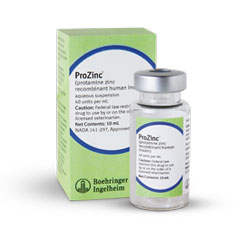ProZinc Insulin
First protamine zinc insulin approved by the FDA for use in dogs & cats
Veterinarian Prescription (Rx) Required
Cooler Item; must ship Express
Low Price Match Guarantee
- Protamine zinc recombitant human insulin
- 10mL Vial
- Aqueous suspension
Description
ProZinc is the first protamine zinc insulin that is approved by the FDA specifically for use in cats that releases slowly over time to maintain a stable, consistent blood glucose level throughout the day.
The PROZINC syringe
When you give your pet a PROZINC injection, make sure you use the correct type of syringe. PROZINC is a U-40 insulin, meaning that there are 40 units of insulin per milliliter (ml) of product. That is why PROZINC must be injected with a U-40 syringe. This is very important because using another type of syringe will deliver the wrong dose.
Uses
PROZINC (protamine zinc recombinant human insulin) is an injectable insulin for cats and dogs. PROZINC is an aqueous suspension of protamine zinc recombinant human insulin that is indicated to reduce hyperglycemia (high blood glucose or high blood sugar) and clinical signs associated with hyperglycemia in cats and dogs with diabetes mellitus.
Possible Side Effects
Cats and dogs presenting with severe ketoacidosis, anorexia, lethargy, and/or vomiting should be stabilized with short-acting insulin and appropriate supportive therapy until their condition is stabilized. As with all insulin products, careful patient monitoring for hypoglycemia and hyperglycemia is essential to attain and maintain adequate glycemic control and to prevent associated complications. Overdose can result in profound hypoglycemia and death. Glucocorticoids, progestogens, and certain endocrinopathies can have an antagonistic effect on insulin activity. Glucocorticoid and progestogen use should be avoided. The safety and effectiveness of PROZINC in breeding, pregnant, and lactating cats and dogs has not been evaluated. The safety and effectiveness of PROZINC in kittens and puppies has not been evaluated.
Dosage for Cats
All weights
Before using ProZinc you should have your vet the proper way to inject insulin. Your cat's injection should be given at feeding time or just afterward. Give the injections at the same time every day, approximately 12 hours apart to help your cat maintain the most stable blood glucose levels. The initial recommended dose is 0.1 - 0.3 IU insulin/pound of body weight (0.2-0.7 IU/kg) every 12 hours.
Dosage for Dogs
All weights
Before using ProZinc you should have your vet the proper way to inject insulin. Your dog's injection should be given at feeding time or just afterward. Give the injections at the same time every day, to help your dog maintain the most stable blood glucose levels. The initial recommended dose is 0.2 - 0.5 IU insulin/pound of body weight (0.5-1.0 IU/kg) daily.
Cautions
Federal law restricts this drug to use by or on the order of a licensed veterinarian.
Contraindications
PROZINC is contraindicated in cats sensitive to protamine zinc recombinant human insulin or any other ingredients in PROZINC. PROZINC is contraindicated during episodes of hypoglycemia.
Warnings
User Safety
For use in cats and dogs only. Keep out of the reach of children. Avoid contact with eyes. In case of contact, immediately flush eyes with running water for at least 15 minutes. Accidental injection may cause hypoglycemia. In case of accidental injection, seek medical attention immediately. Exposure to product may induce a local or systemic allergic reaction in sensitized individuals.
Animal Safety
Owners should be advised to observe for signs of hypoglycemia (see Client Information Sheet). Use of this product, even at established doses, has been associated with hypoglycemia. A cat with signs of hypoglycemia should be treated immediately. Glucose should be given orally or intravenously as dictated by clinical signs. Insulin should be temporarily withheld and, if indicated, the dosage adjusted.
Any change in insulin should be made cautiously and only under a veterinarian's supervision. Changes in insulin strength, manufacturer, type, species (human, animal) or method of manufacture (rDNA versus animal-source insulin) may result in the need for a change in dosage.
Appropriate diagnostic tests should be performed to rule out other endocrinopathies in diabetic cats that are difficult to regulate.
Precautions
Cats presenting with severe ketoacidosis, anorexia, lethargy, and/or vomiting should be stabilized with short-acting insulin and appropriate supportive therapy until their condition is stabilized. As with all insulin products, careful patient monitoring for hypoglycemia and hyperglycemia is essential to attain and maintain adequate glycemic control and to prevent associated complications. Overdose can result in profound hypoglycemia and death.
Glucocorticoids, progestogens, and certain endocrinopathies can have an antagonistic effect on insulin activity. Glucocorticoid and progestogen use should be avoided.
The safety and effectiveness of PROZINC in breeding, pregnant, and lactating cats has not been evaluated.
The safety and effectiveness of PROZINC in kittens has not been evaluated.
Adverse Reactions
Effectiveness Field Study
In a 45-day effectiveness field study, 176 cats received PROZINC. Hypoglycemia (defined as a blood glucose value of < 50 mg/dL) occurred in 71 of the cats at various times throughout the study. Clinical signs of hypoglycemia were generally mild in nature (described as lethargic, sluggish, weak, trembling, uncoordinated, groggy, glassy-eyed or dazed). In 17 cases, the veterinarian provided oral glucose supplementation or food as treatment. Most cases were not associated with clinical signs and received no treatment. One cat had a serious hypoglycemic event associated with stupor, lateral recumbency, hypothermia and seizures.
All cases of hypoglycemia resolved with appropriate therapy and if needed, a dose reduction.
Three cats had injection site reactions which were described as either small, punctate, red lesions; lesions on neck; or palpable subcutaneous thickening. All injection site reactions resolved without cessation of therapy.
Four cats developed diabetic neuropathy during the study as evidenced by plantigrade stance. Three cats entered the study with plantigrade stance, one of which resolved by Day 45. Four cats were diagnosed with diabetic ketoacidosis during the study. Two were euthanized due to poor response to treatment. Five other cats were euthanized during the study, one of which had hypoglycemia. Four cats had received PROZINC for less than a week and were euthanized due to worsening concurrent medical conditions.
The following additional clinical observations or diagnoses were reported in cats during the effectiveness field study: vomiting, lethargy, diarrhea, cystitis/hematuria, upper respiratory infection, dry coat, hair loss, ocular discharge, abnormal vocalization, black stool, and rapid breathing.
Extended Use Field Study
Cats that completed the effectiveness study were enrolled into an extended use field study. In this study, 145 cats received PROZINC for up to an additional 136 days. Adverse reactions were similar to those reported during the 45-day effectiveness study and are listed in order of decreasing frequency: vomiting, hypoglycemia, anorexia/poor appetite, diarrhea, lethargy, cystitis/hematuria, and weakness. Twenty cats had signs consistent with hypoglycemia described as: sluggish, lethargic, unsteady, wobbly, seizures, trembling, or dazed. Most of these were treated by the owner or veterinarian with oral glucose supplementation or food; others received intravenous glucose. One cat had a serious hypoglycemic event associated with seizures and blindness. The cat fully recovered after supportive therapy and finished the study. All cases of hypoglycemia resolved with appropriate therapy and if needed, a dose reduction.
Fourteen cats died or were euthanized during the extended use study. In two cases, continued use of insulin despite anorexia and signs of hypoglycemia contributed to the deaths. In one case, the owner decided not to continue therapy after a presumed episode of hypoglycemia. The rest were due to concurrent medical conditions or worsening of the diabetes mellitus.
To report suspected adverse drug events, for technical assistance or to obtain a copy of the Safety Data Sheet (SDS), contact Boehringer Ingelheim at 1-888-637-4251.
For additional information about adverse drug experience reporting for animal drugs, contact FDA at 1-888-FDA-VETS or online at www.fda.gov/reportanimalae.
Information for Cat Owners
Please refer to the Client Information Sheet for Cats for more information about PROZINC. PROZINC, like other insulin products, is not free from adverse reactions. Owners should be advised of the potential for adverse reactions and be informed of the associated clinical signs. Potential adverse reactions include: hypoglycemia, insulin antagonism/resistance, rapid insulin metabolism, insulin-induced hyperglycemia (Somogyi Effect), and local or systemic reactions. The most common adverse reaction observed is hypoglycemia. Signs may include: weakness, depression, behavioral changes, muscle twitching, and anxiety. In severe cases of hypoglycemia, seizures and coma can occur. Hypoglycemia can be fatal if an affected cat does not receive prompt treatment. Appropriate veterinary monitoring of blood glucose, adjustment of insulin dose and regimen as needed, and stabilization of diet and activity help minimize the risk of hypoglycemic episodes. The attending veterinarian should evaluate other adverse reactions on a case-by-case basis to determine if an adjustment in therapy is appropriate, or if alternative therapy should be considered.
Effectiveness
A total of 187 client-owned cats were enrolled in a 45-day field study, with 176 receiving PROZINC. One hundred and fifty-one cats were included in the effectiveness analysis. The patients included various purebred and mixed breed cats ranging in age from 3 to 19 years and in weight from 4.6 to 20.8 pounds. Of the cats included in the effectiveness analysis, 101 were castrated males, 49 were spayed females, and 1 was an intact female.
Cats were started on PROZINC at a dose of 0.1-0.3 IU/lb (0.2-0.7 IU/kg) twice daily. Cats were evaluated at 7, 14, 30, and 45 days after initiation of therapy and the dose was adjusted based on clinical signs and results of 9-hour blood glucose curves on Days 7, 14, and 30.
Effectiveness was based on successful control of diabetes which was defined as improvement in at least one blood glucose variable (glucose curve mean, nadir, or fructosamine) and at least one clinical sign (polyuria, polydipsia, or body weight). Based on this definition, 115 of 151 cases (76.2%) were considered successful. Blood glucose curve means decreased from 415.3 mg/dL on Day 0 to 203.2 mg/dL by Day 45 and the mean blood glucose nadir decreased from 407.9 mg/dL on Day 0 to 142.4 mg/dL on Day 45. Mean fructosamine values decreased from 505.9 µmol/L on Day 0 to 380.7 µmol/L on Day 45.
Cats that completed the effectiveness study were enrolled in an extended use field study. The mean fructosamine value was 342.0 µmol/L after a total of 181 days of PROZINC therapy.
Storage
Store in an upright position under refrigeration at 36-46°F (2-8°C). Do not freeze. Protect from light. Use the 10 mL vial within 60 days of first puncture. Use the 20 mL vial within 80 days of first puncture.
| All Vaccines Now Ship OVERNIGHT Delivery Only at a great LOW Rate! Vaccines are shipped in a cooling package. Click here for our Vaccine Shipping Schedule. |







